Marketing Management Assignment: Ethical and Strategic Analysis
VerifiedAdded on 2022/08/08
|14
|3360
|19
Homework Assignment
AI Summary
This marketing management assignment delves into core marketing concepts, including the differences and commonalities between strategic planning and marketing management. It explores the ethical responsibilities of marketers, defines strategy, and examines its role in organizational planning, including competitive strategies. The assignment analyzes ethical considerations in telemarketing and email marketing, suggesting do's and don'ts for marketers. It also addresses strategies for increasing sales of an existing FMCG product using the Ansoff matrix and discusses market research methodologies, including qualitative and quantitative approaches. Furthermore, the assignment covers the BCG matrix, marketing mix, and competitor analysis. Finally, it examines market and marketing definitions, as well as the role of the marketing mix, and provides solutions to various marketing challenges.
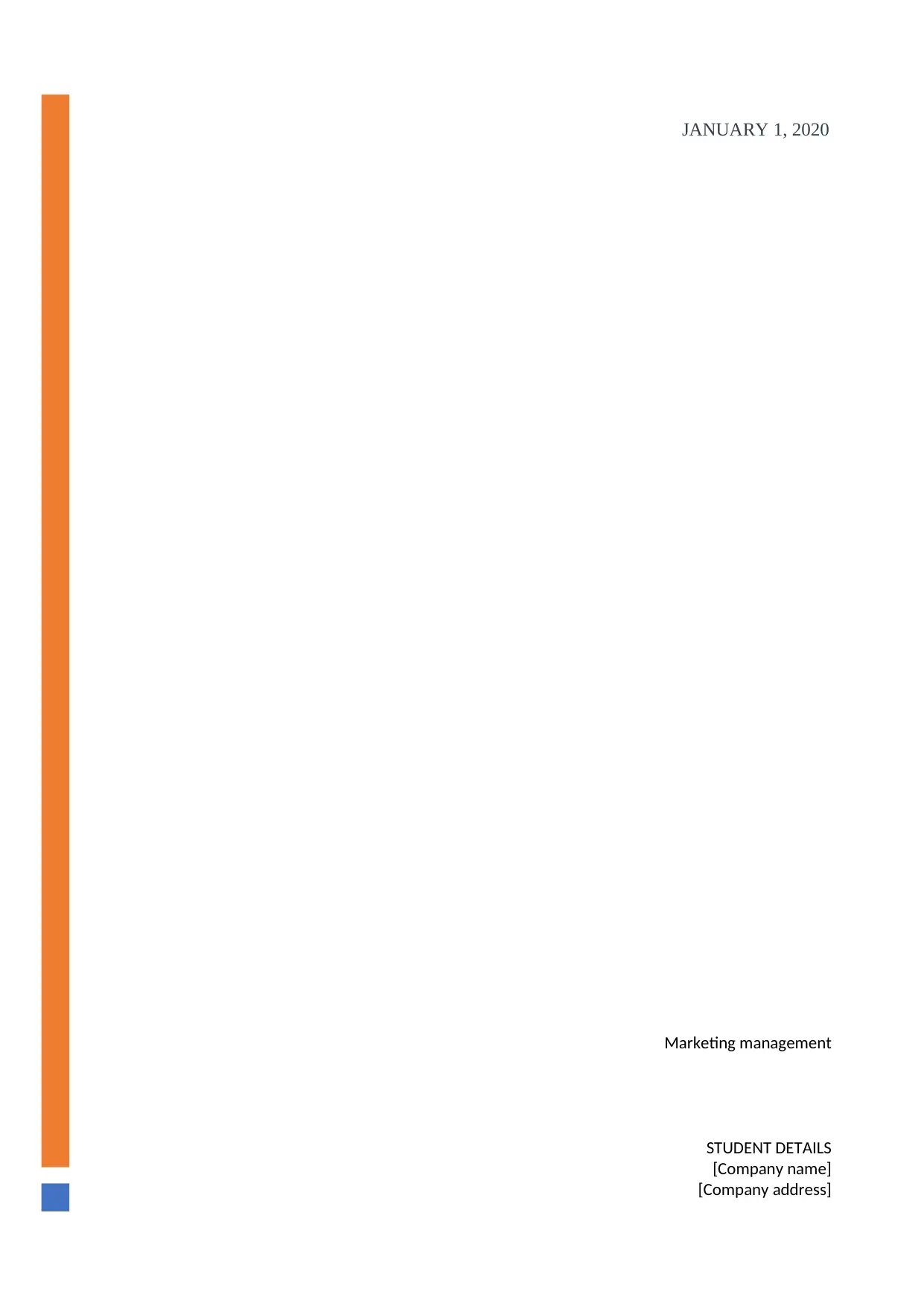
Marketing management
STUDENT DETAILS
[Company name]
[Company address]
JANUARY 1, 2020
STUDENT DETAILS
[Company name]
[Company address]
JANUARY 1, 2020
Paraphrase This Document
Need a fresh take? Get an instant paraphrase of this document with our AI Paraphraser
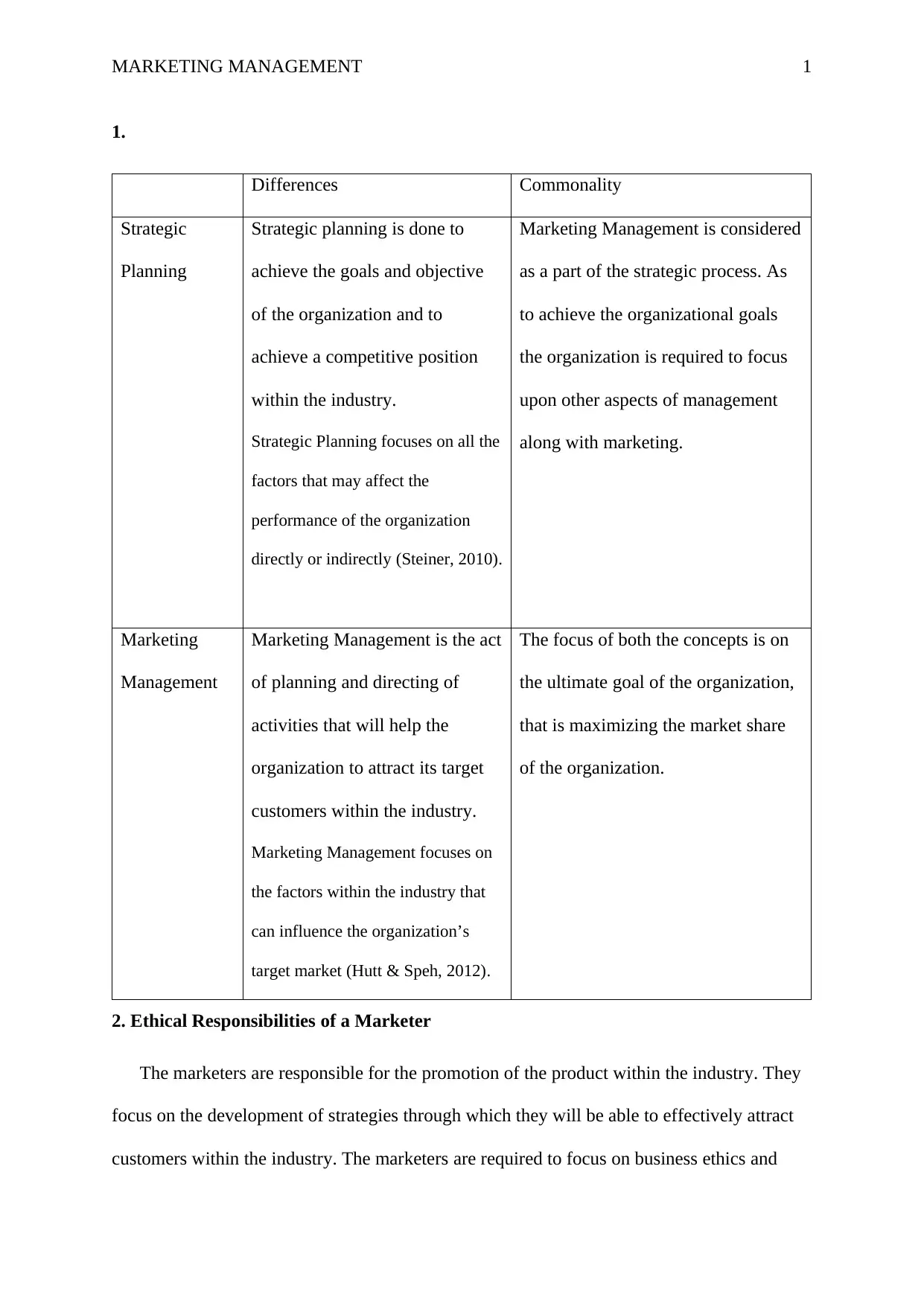
MARKETING MANAGEMENT 1
1.
Differences Commonality
Strategic
Planning
Strategic planning is done to
achieve the goals and objective
of the organization and to
achieve a competitive position
within the industry.
Strategic Planning focuses on all the
factors that may affect the
performance of the organization
directly or indirectly (Steiner, 2010).
Marketing Management is considered
as a part of the strategic process. As
to achieve the organizational goals
the organization is required to focus
upon other aspects of management
along with marketing.
Marketing
Management
Marketing Management is the act
of planning and directing of
activities that will help the
organization to attract its target
customers within the industry.
Marketing Management focuses on
the factors within the industry that
can influence the organization’s
target market (Hutt & Speh, 2012).
The focus of both the concepts is on
the ultimate goal of the organization,
that is maximizing the market share
of the organization.
2. Ethical Responsibilities of a Marketer
The marketers are responsible for the promotion of the product within the industry. They
focus on the development of strategies through which they will be able to effectively attract
customers within the industry. The marketers are required to focus on business ethics and
1.
Differences Commonality
Strategic
Planning
Strategic planning is done to
achieve the goals and objective
of the organization and to
achieve a competitive position
within the industry.
Strategic Planning focuses on all the
factors that may affect the
performance of the organization
directly or indirectly (Steiner, 2010).
Marketing Management is considered
as a part of the strategic process. As
to achieve the organizational goals
the organization is required to focus
upon other aspects of management
along with marketing.
Marketing
Management
Marketing Management is the act
of planning and directing of
activities that will help the
organization to attract its target
customers within the industry.
Marketing Management focuses on
the factors within the industry that
can influence the organization’s
target market (Hutt & Speh, 2012).
The focus of both the concepts is on
the ultimate goal of the organization,
that is maximizing the market share
of the organization.
2. Ethical Responsibilities of a Marketer
The marketers are responsible for the promotion of the product within the industry. They
focus on the development of strategies through which they will be able to effectively attract
customers within the industry. The marketers are required to focus on business ethics and
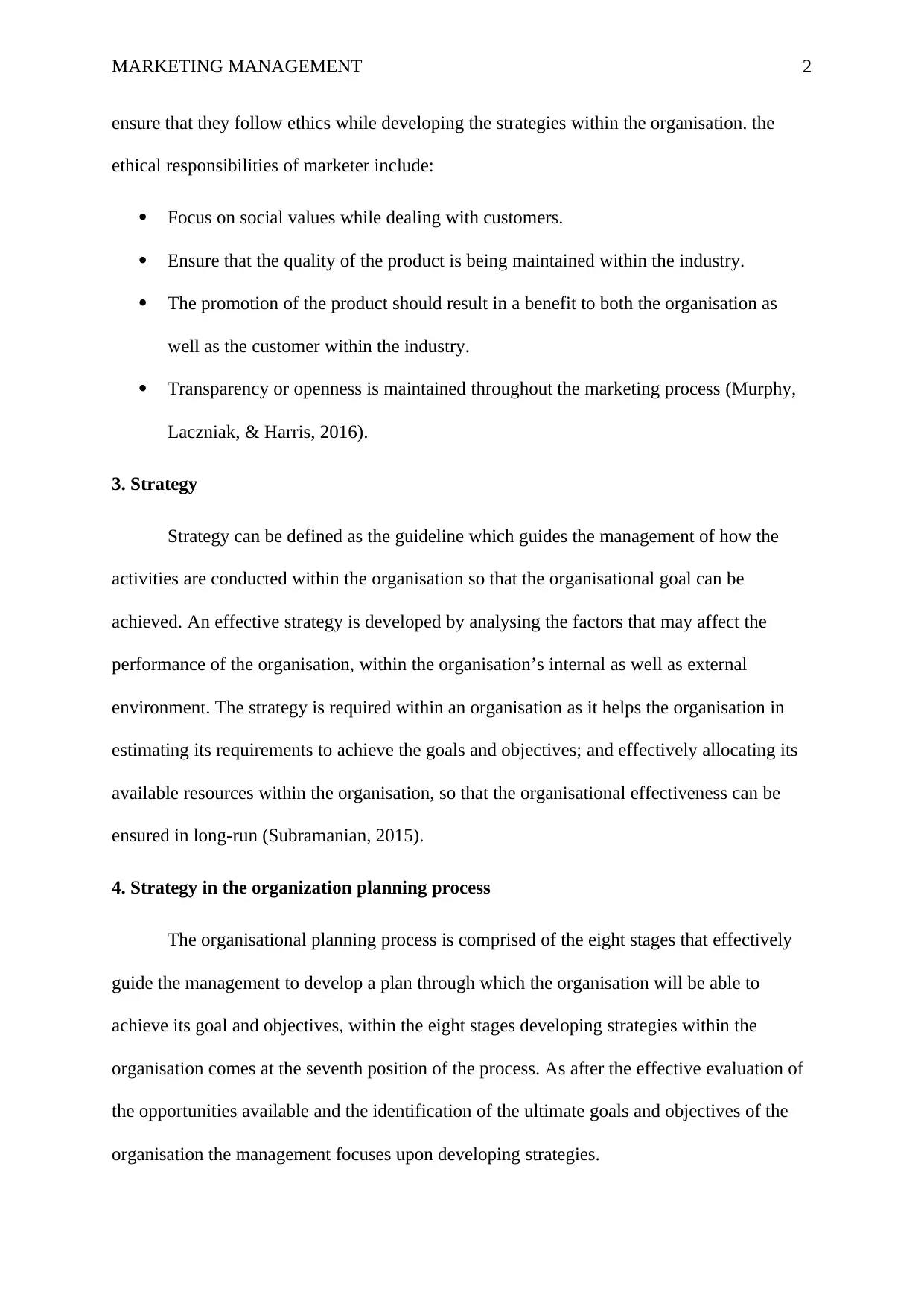
MARKETING MANAGEMENT 2
ensure that they follow ethics while developing the strategies within the organisation. the
ethical responsibilities of marketer include:
Focus on social values while dealing with customers.
Ensure that the quality of the product is being maintained within the industry.
The promotion of the product should result in a benefit to both the organisation as
well as the customer within the industry.
Transparency or openness is maintained throughout the marketing process (Murphy,
Laczniak, & Harris, 2016).
3. Strategy
Strategy can be defined as the guideline which guides the management of how the
activities are conducted within the organisation so that the organisational goal can be
achieved. An effective strategy is developed by analysing the factors that may affect the
performance of the organisation, within the organisation’s internal as well as external
environment. The strategy is required within an organisation as it helps the organisation in
estimating its requirements to achieve the goals and objectives; and effectively allocating its
available resources within the organisation, so that the organisational effectiveness can be
ensured in long-run (Subramanian, 2015).
4. Strategy in the organization planning process
The organisational planning process is comprised of the eight stages that effectively
guide the management to develop a plan through which the organisation will be able to
achieve its goal and objectives, within the eight stages developing strategies within the
organisation comes at the seventh position of the process. As after the effective evaluation of
the opportunities available and the identification of the ultimate goals and objectives of the
organisation the management focuses upon developing strategies.
ensure that they follow ethics while developing the strategies within the organisation. the
ethical responsibilities of marketer include:
Focus on social values while dealing with customers.
Ensure that the quality of the product is being maintained within the industry.
The promotion of the product should result in a benefit to both the organisation as
well as the customer within the industry.
Transparency or openness is maintained throughout the marketing process (Murphy,
Laczniak, & Harris, 2016).
3. Strategy
Strategy can be defined as the guideline which guides the management of how the
activities are conducted within the organisation so that the organisational goal can be
achieved. An effective strategy is developed by analysing the factors that may affect the
performance of the organisation, within the organisation’s internal as well as external
environment. The strategy is required within an organisation as it helps the organisation in
estimating its requirements to achieve the goals and objectives; and effectively allocating its
available resources within the organisation, so that the organisational effectiveness can be
ensured in long-run (Subramanian, 2015).
4. Strategy in the organization planning process
The organisational planning process is comprised of the eight stages that effectively
guide the management to develop a plan through which the organisation will be able to
achieve its goal and objectives, within the eight stages developing strategies within the
organisation comes at the seventh position of the process. As after the effective evaluation of
the opportunities available and the identification of the ultimate goals and objectives of the
organisation the management focuses upon developing strategies.
⊘ This is a preview!⊘
Do you want full access?
Subscribe today to unlock all pages.

Trusted by 1+ million students worldwide
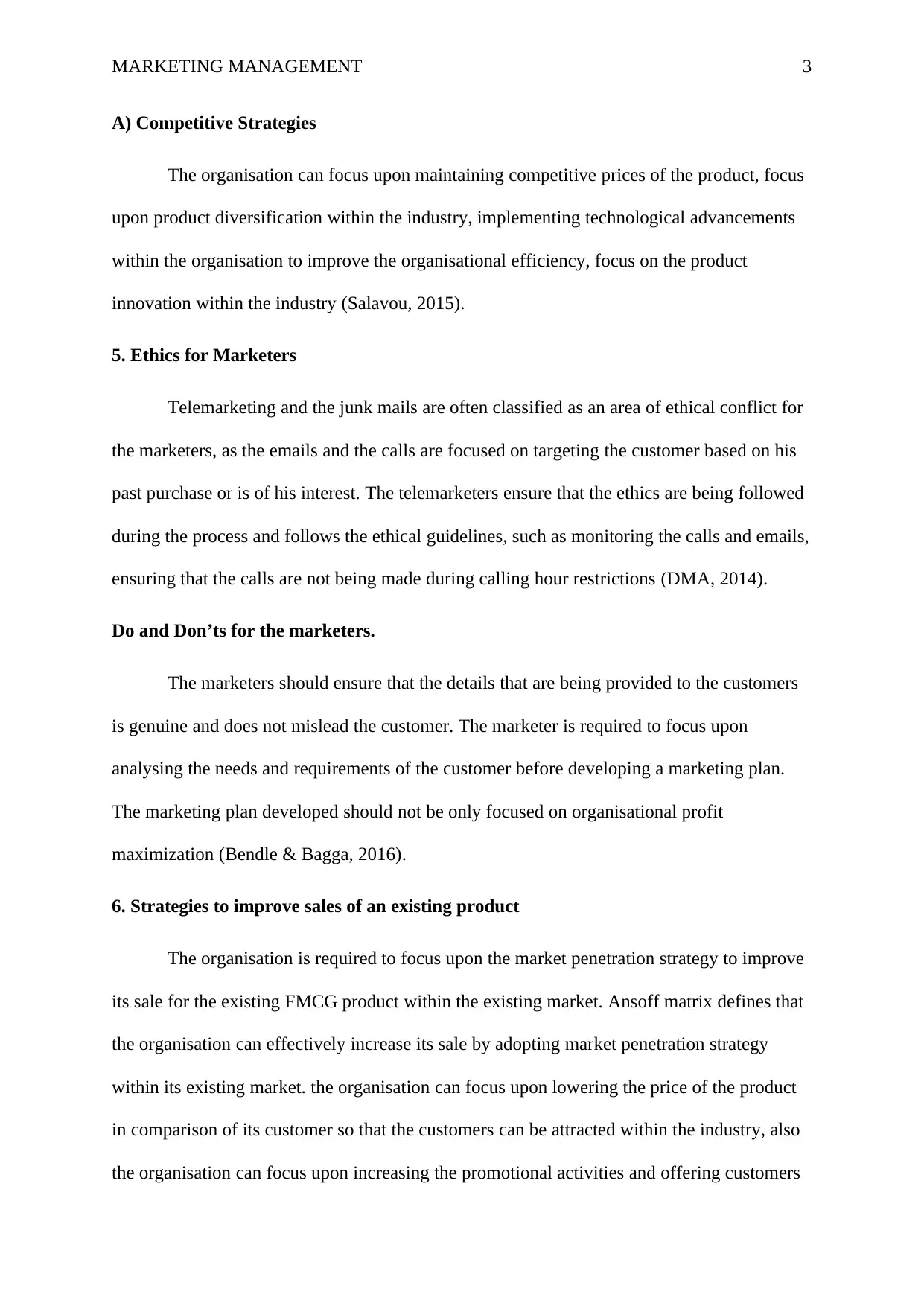
MARKETING MANAGEMENT 3
A) Competitive Strategies
The organisation can focus upon maintaining competitive prices of the product, focus
upon product diversification within the industry, implementing technological advancements
within the organisation to improve the organisational efficiency, focus on the product
innovation within the industry (Salavou, 2015).
5. Ethics for Marketers
Telemarketing and the junk mails are often classified as an area of ethical conflict for
the marketers, as the emails and the calls are focused on targeting the customer based on his
past purchase or is of his interest. The telemarketers ensure that the ethics are being followed
during the process and follows the ethical guidelines, such as monitoring the calls and emails,
ensuring that the calls are not being made during calling hour restrictions (DMA, 2014).
Do and Don’ts for the marketers.
The marketers should ensure that the details that are being provided to the customers
is genuine and does not mislead the customer. The marketer is required to focus upon
analysing the needs and requirements of the customer before developing a marketing plan.
The marketing plan developed should not be only focused on organisational profit
maximization (Bendle & Bagga, 2016).
6. Strategies to improve sales of an existing product
The organisation is required to focus upon the market penetration strategy to improve
its sale for the existing FMCG product within the existing market. Ansoff matrix defines that
the organisation can effectively increase its sale by adopting market penetration strategy
within its existing market. the organisation can focus upon lowering the price of the product
in comparison of its customer so that the customers can be attracted within the industry, also
the organisation can focus upon increasing the promotional activities and offering customers
A) Competitive Strategies
The organisation can focus upon maintaining competitive prices of the product, focus
upon product diversification within the industry, implementing technological advancements
within the organisation to improve the organisational efficiency, focus on the product
innovation within the industry (Salavou, 2015).
5. Ethics for Marketers
Telemarketing and the junk mails are often classified as an area of ethical conflict for
the marketers, as the emails and the calls are focused on targeting the customer based on his
past purchase or is of his interest. The telemarketers ensure that the ethics are being followed
during the process and follows the ethical guidelines, such as monitoring the calls and emails,
ensuring that the calls are not being made during calling hour restrictions (DMA, 2014).
Do and Don’ts for the marketers.
The marketers should ensure that the details that are being provided to the customers
is genuine and does not mislead the customer. The marketer is required to focus upon
analysing the needs and requirements of the customer before developing a marketing plan.
The marketing plan developed should not be only focused on organisational profit
maximization (Bendle & Bagga, 2016).
6. Strategies to improve sales of an existing product
The organisation is required to focus upon the market penetration strategy to improve
its sale for the existing FMCG product within the existing market. Ansoff matrix defines that
the organisation can effectively increase its sale by adopting market penetration strategy
within its existing market. the organisation can focus upon lowering the price of the product
in comparison of its customer so that the customers can be attracted within the industry, also
the organisation can focus upon increasing the promotional activities and offering customers
Paraphrase This Document
Need a fresh take? Get an instant paraphrase of this document with our AI Paraphraser
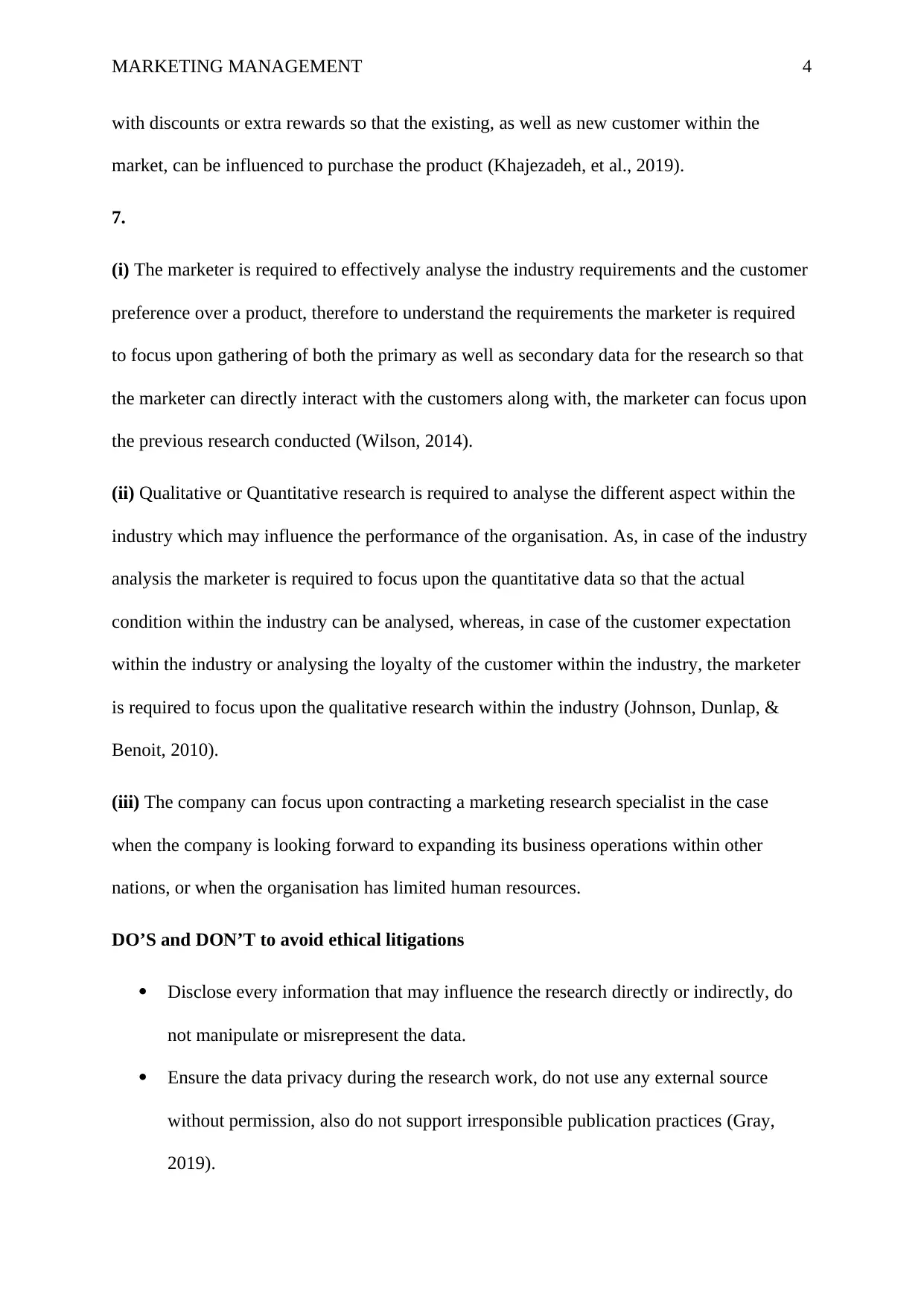
MARKETING MANAGEMENT 4
with discounts or extra rewards so that the existing, as well as new customer within the
market, can be influenced to purchase the product (Khajezadeh, et al., 2019).
7.
(i) The marketer is required to effectively analyse the industry requirements and the customer
preference over a product, therefore to understand the requirements the marketer is required
to focus upon gathering of both the primary as well as secondary data for the research so that
the marketer can directly interact with the customers along with, the marketer can focus upon
the previous research conducted (Wilson, 2014).
(ii) Qualitative or Quantitative research is required to analyse the different aspect within the
industry which may influence the performance of the organisation. As, in case of the industry
analysis the marketer is required to focus upon the quantitative data so that the actual
condition within the industry can be analysed, whereas, in case of the customer expectation
within the industry or analysing the loyalty of the customer within the industry, the marketer
is required to focus upon the qualitative research within the industry (Johnson, Dunlap, &
Benoit, 2010).
(iii) The company can focus upon contracting a marketing research specialist in the case
when the company is looking forward to expanding its business operations within other
nations, or when the organisation has limited human resources.
DO’S and DON’T to avoid ethical litigations
Disclose every information that may influence the research directly or indirectly, do
not manipulate or misrepresent the data.
Ensure the data privacy during the research work, do not use any external source
without permission, also do not support irresponsible publication practices (Gray,
2019).
with discounts or extra rewards so that the existing, as well as new customer within the
market, can be influenced to purchase the product (Khajezadeh, et al., 2019).
7.
(i) The marketer is required to effectively analyse the industry requirements and the customer
preference over a product, therefore to understand the requirements the marketer is required
to focus upon gathering of both the primary as well as secondary data for the research so that
the marketer can directly interact with the customers along with, the marketer can focus upon
the previous research conducted (Wilson, 2014).
(ii) Qualitative or Quantitative research is required to analyse the different aspect within the
industry which may influence the performance of the organisation. As, in case of the industry
analysis the marketer is required to focus upon the quantitative data so that the actual
condition within the industry can be analysed, whereas, in case of the customer expectation
within the industry or analysing the loyalty of the customer within the industry, the marketer
is required to focus upon the qualitative research within the industry (Johnson, Dunlap, &
Benoit, 2010).
(iii) The company can focus upon contracting a marketing research specialist in the case
when the company is looking forward to expanding its business operations within other
nations, or when the organisation has limited human resources.
DO’S and DON’T to avoid ethical litigations
Disclose every information that may influence the research directly or indirectly, do
not manipulate or misrepresent the data.
Ensure the data privacy during the research work, do not use any external source
without permission, also do not support irresponsible publication practices (Gray,
2019).
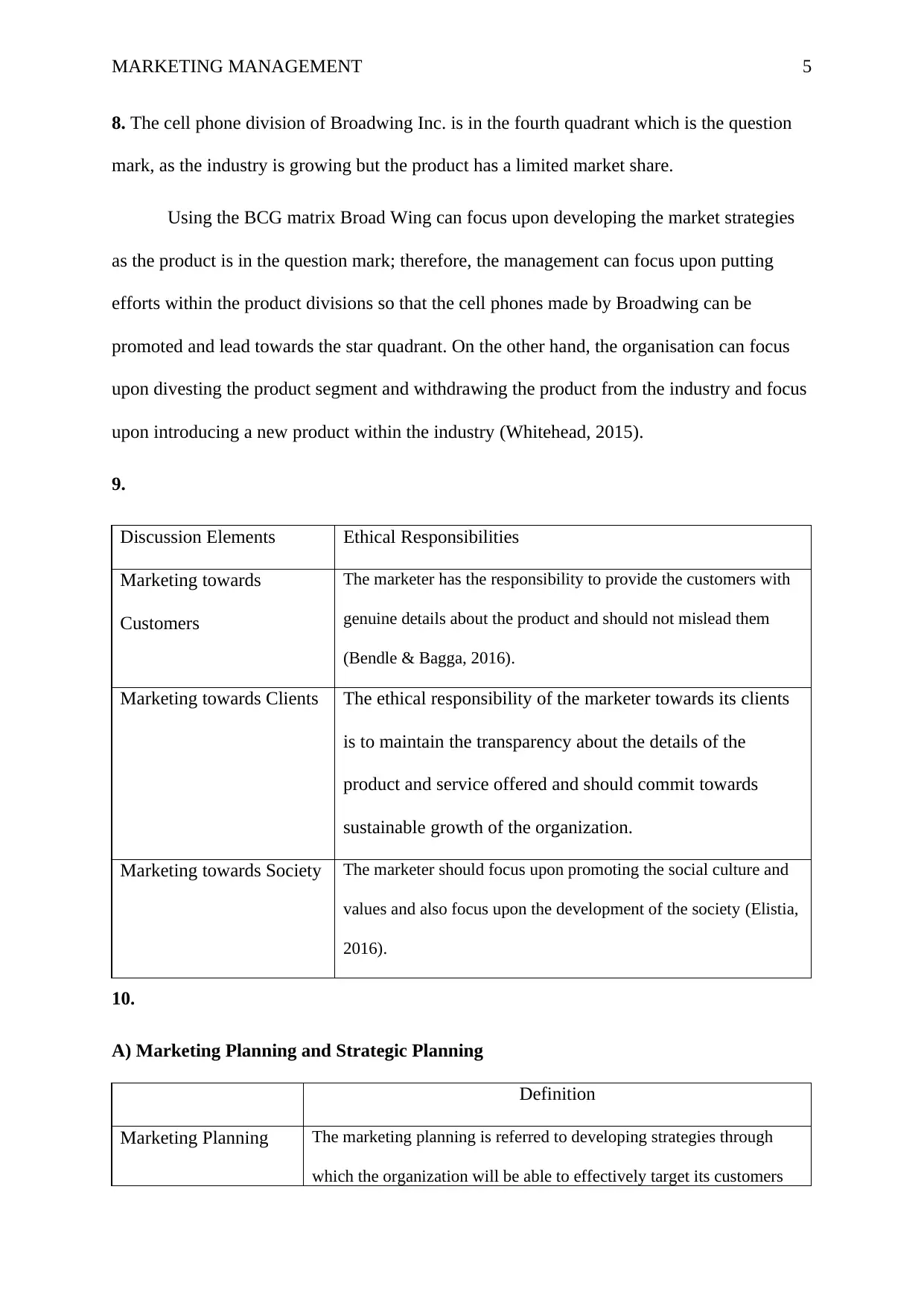
MARKETING MANAGEMENT 5
8. The cell phone division of Broadwing Inc. is in the fourth quadrant which is the question
mark, as the industry is growing but the product has a limited market share.
Using the BCG matrix Broad Wing can focus upon developing the market strategies
as the product is in the question mark; therefore, the management can focus upon putting
efforts within the product divisions so that the cell phones made by Broadwing can be
promoted and lead towards the star quadrant. On the other hand, the organisation can focus
upon divesting the product segment and withdrawing the product from the industry and focus
upon introducing a new product within the industry (Whitehead, 2015).
9.
Discussion Elements Ethical Responsibilities
Marketing towards
Customers
The marketer has the responsibility to provide the customers with
genuine details about the product and should not mislead them
(Bendle & Bagga, 2016).
Marketing towards Clients The ethical responsibility of the marketer towards its clients
is to maintain the transparency about the details of the
product and service offered and should commit towards
sustainable growth of the organization.
Marketing towards Society The marketer should focus upon promoting the social culture and
values and also focus upon the development of the society (Elistia,
2016).
10.
A) Marketing Planning and Strategic Planning
Definition
Marketing Planning The marketing planning is referred to developing strategies through
which the organization will be able to effectively target its customers
8. The cell phone division of Broadwing Inc. is in the fourth quadrant which is the question
mark, as the industry is growing but the product has a limited market share.
Using the BCG matrix Broad Wing can focus upon developing the market strategies
as the product is in the question mark; therefore, the management can focus upon putting
efforts within the product divisions so that the cell phones made by Broadwing can be
promoted and lead towards the star quadrant. On the other hand, the organisation can focus
upon divesting the product segment and withdrawing the product from the industry and focus
upon introducing a new product within the industry (Whitehead, 2015).
9.
Discussion Elements Ethical Responsibilities
Marketing towards
Customers
The marketer has the responsibility to provide the customers with
genuine details about the product and should not mislead them
(Bendle & Bagga, 2016).
Marketing towards Clients The ethical responsibility of the marketer towards its clients
is to maintain the transparency about the details of the
product and service offered and should commit towards
sustainable growth of the organization.
Marketing towards Society The marketer should focus upon promoting the social culture and
values and also focus upon the development of the society (Elistia,
2016).
10.
A) Marketing Planning and Strategic Planning
Definition
Marketing Planning The marketing planning is referred to developing strategies through
which the organization will be able to effectively target its customers
⊘ This is a preview!⊘
Do you want full access?
Subscribe today to unlock all pages.

Trusted by 1+ million students worldwide
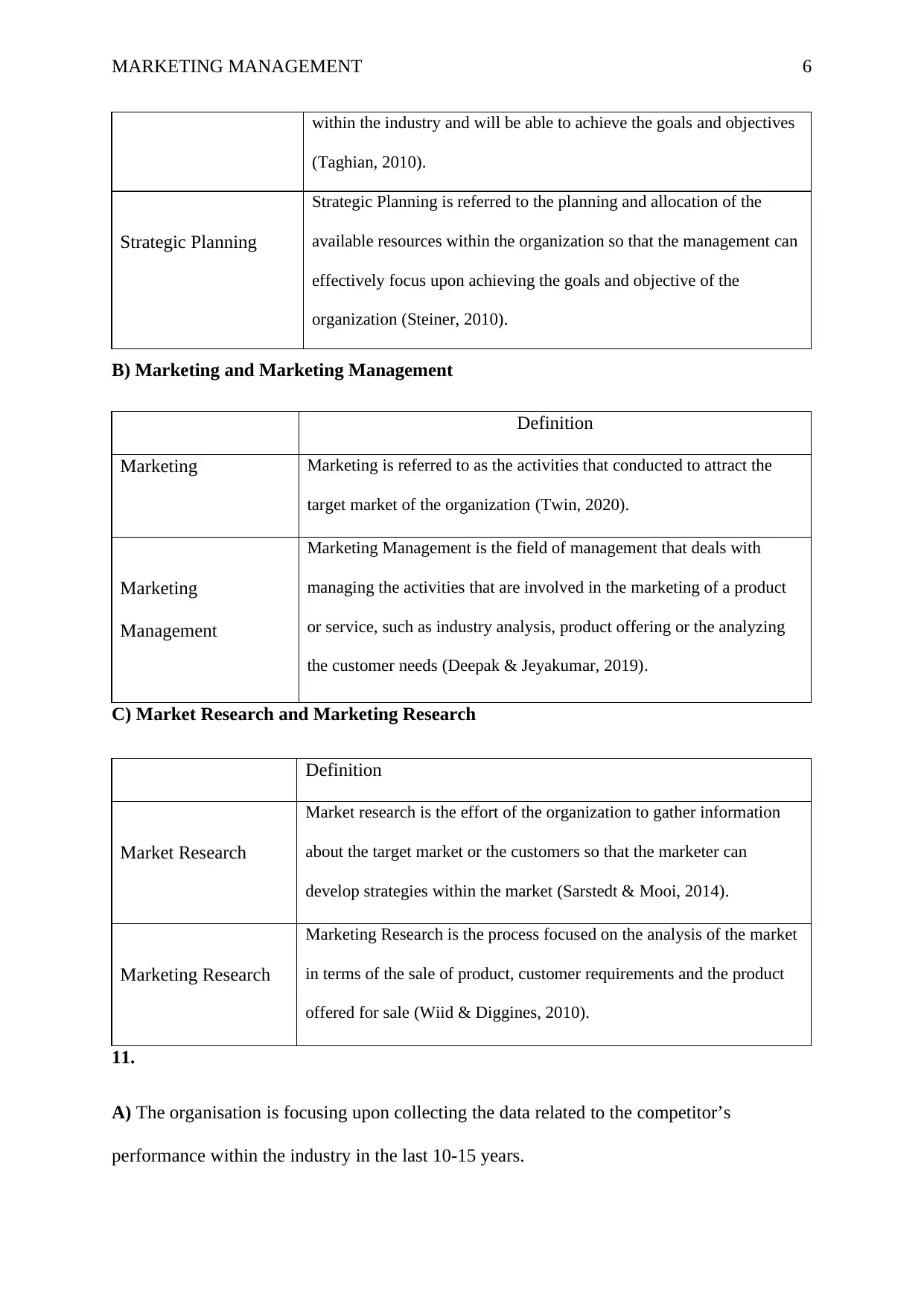
MARKETING MANAGEMENT 6
within the industry and will be able to achieve the goals and objectives
(Taghian, 2010).
Strategic Planning
Strategic Planning is referred to the planning and allocation of the
available resources within the organization so that the management can
effectively focus upon achieving the goals and objective of the
organization (Steiner, 2010).
B) Marketing and Marketing Management
Definition
Marketing Marketing is referred to as the activities that conducted to attract the
target market of the organization (Twin, 2020).
Marketing
Management
Marketing Management is the field of management that deals with
managing the activities that are involved in the marketing of a product
or service, such as industry analysis, product offering or the analyzing
the customer needs (Deepak & Jeyakumar, 2019).
C) Market Research and Marketing Research
Definition
Market Research
Market research is the effort of the organization to gather information
about the target market or the customers so that the marketer can
develop strategies within the market (Sarstedt & Mooi, 2014).
Marketing Research
Marketing Research is the process focused on the analysis of the market
in terms of the sale of product, customer requirements and the product
offered for sale (Wiid & Diggines, 2010).
11.
A) The organisation is focusing upon collecting the data related to the competitor’s
performance within the industry in the last 10-15 years.
within the industry and will be able to achieve the goals and objectives
(Taghian, 2010).
Strategic Planning
Strategic Planning is referred to the planning and allocation of the
available resources within the organization so that the management can
effectively focus upon achieving the goals and objective of the
organization (Steiner, 2010).
B) Marketing and Marketing Management
Definition
Marketing Marketing is referred to as the activities that conducted to attract the
target market of the organization (Twin, 2020).
Marketing
Management
Marketing Management is the field of management that deals with
managing the activities that are involved in the marketing of a product
or service, such as industry analysis, product offering or the analyzing
the customer needs (Deepak & Jeyakumar, 2019).
C) Market Research and Marketing Research
Definition
Market Research
Market research is the effort of the organization to gather information
about the target market or the customers so that the marketer can
develop strategies within the market (Sarstedt & Mooi, 2014).
Marketing Research
Marketing Research is the process focused on the analysis of the market
in terms of the sale of product, customer requirements and the product
offered for sale (Wiid & Diggines, 2010).
11.
A) The organisation is focusing upon collecting the data related to the competitor’s
performance within the industry in the last 10-15 years.
Paraphrase This Document
Need a fresh take? Get an instant paraphrase of this document with our AI Paraphraser
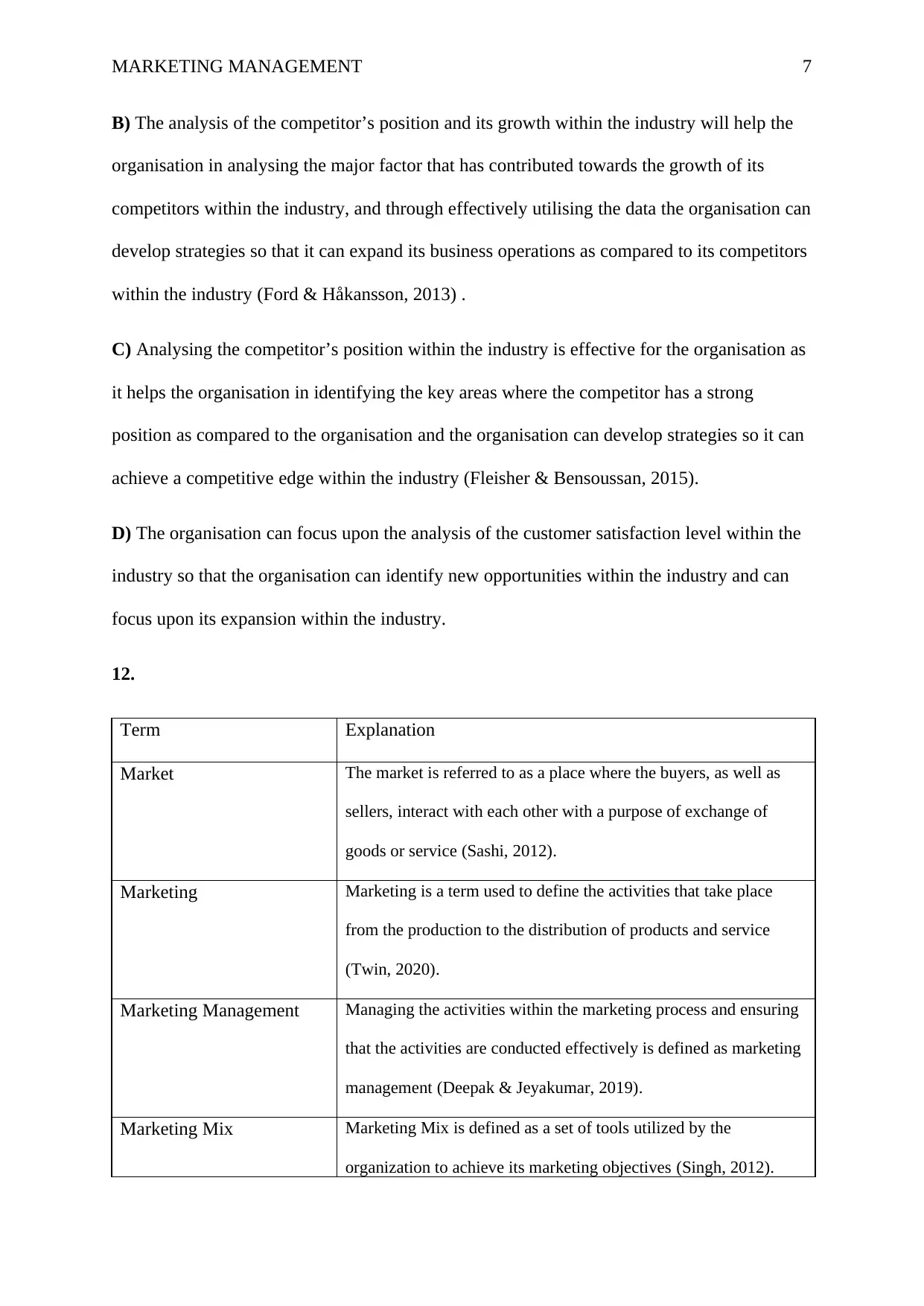
MARKETING MANAGEMENT 7
B) The analysis of the competitor’s position and its growth within the industry will help the
organisation in analysing the major factor that has contributed towards the growth of its
competitors within the industry, and through effectively utilising the data the organisation can
develop strategies so that it can expand its business operations as compared to its competitors
within the industry (Ford & Håkansson, 2013) .
C) Analysing the competitor’s position within the industry is effective for the organisation as
it helps the organisation in identifying the key areas where the competitor has a strong
position as compared to the organisation and the organisation can develop strategies so it can
achieve a competitive edge within the industry (Fleisher & Bensoussan, 2015).
D) The organisation can focus upon the analysis of the customer satisfaction level within the
industry so that the organisation can identify new opportunities within the industry and can
focus upon its expansion within the industry.
12.
Term Explanation
Market The market is referred to as a place where the buyers, as well as
sellers, interact with each other with a purpose of exchange of
goods or service (Sashi, 2012).
Marketing Marketing is a term used to define the activities that take place
from the production to the distribution of products and service
(Twin, 2020).
Marketing Management Managing the activities within the marketing process and ensuring
that the activities are conducted effectively is defined as marketing
management (Deepak & Jeyakumar, 2019).
Marketing Mix Marketing Mix is defined as a set of tools utilized by the
organization to achieve its marketing objectives (Singh, 2012).
B) The analysis of the competitor’s position and its growth within the industry will help the
organisation in analysing the major factor that has contributed towards the growth of its
competitors within the industry, and through effectively utilising the data the organisation can
develop strategies so that it can expand its business operations as compared to its competitors
within the industry (Ford & Håkansson, 2013) .
C) Analysing the competitor’s position within the industry is effective for the organisation as
it helps the organisation in identifying the key areas where the competitor has a strong
position as compared to the organisation and the organisation can develop strategies so it can
achieve a competitive edge within the industry (Fleisher & Bensoussan, 2015).
D) The organisation can focus upon the analysis of the customer satisfaction level within the
industry so that the organisation can identify new opportunities within the industry and can
focus upon its expansion within the industry.
12.
Term Explanation
Market The market is referred to as a place where the buyers, as well as
sellers, interact with each other with a purpose of exchange of
goods or service (Sashi, 2012).
Marketing Marketing is a term used to define the activities that take place
from the production to the distribution of products and service
(Twin, 2020).
Marketing Management Managing the activities within the marketing process and ensuring
that the activities are conducted effectively is defined as marketing
management (Deepak & Jeyakumar, 2019).
Marketing Mix Marketing Mix is defined as a set of tools utilized by the
organization to achieve its marketing objectives (Singh, 2012).
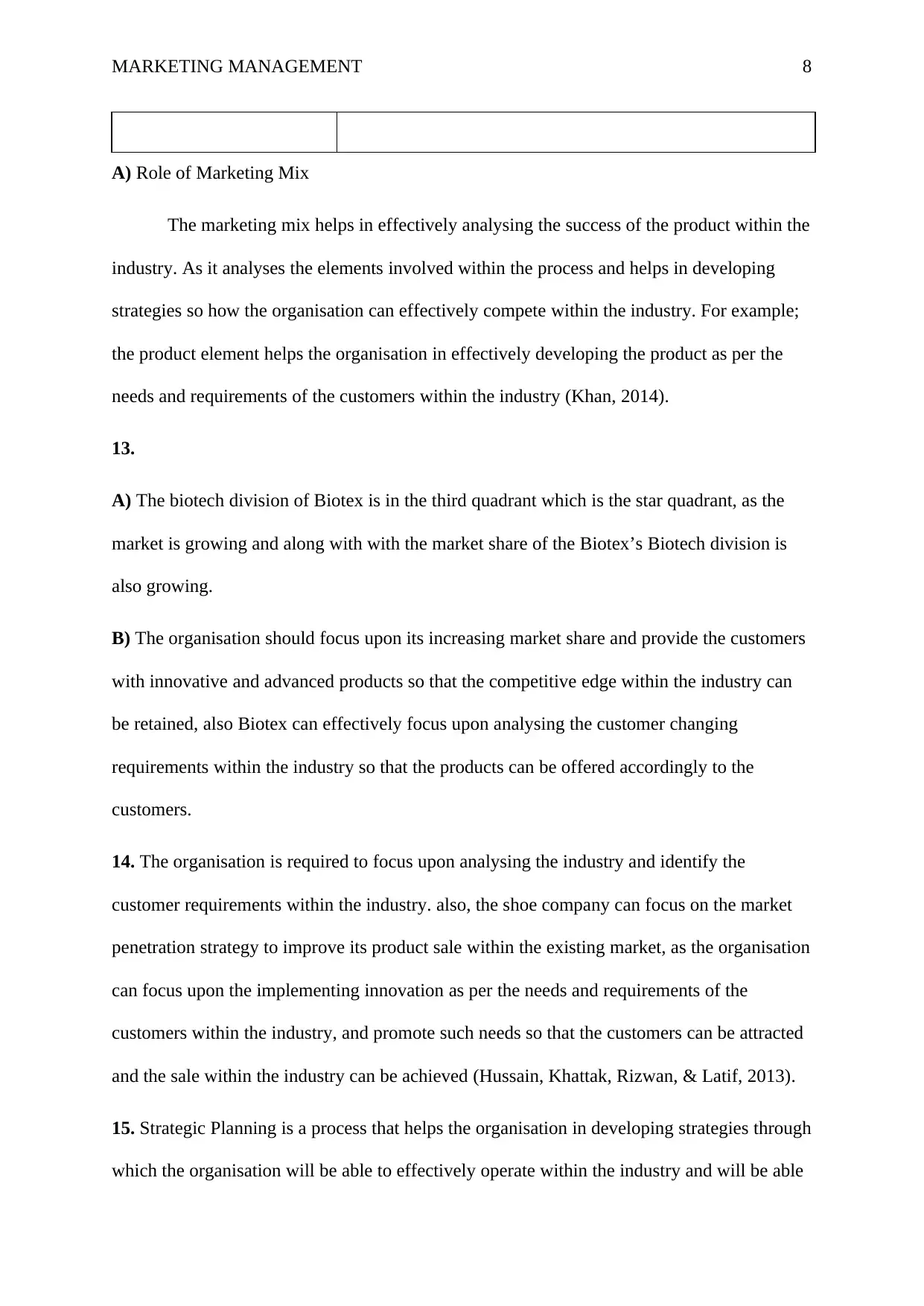
MARKETING MANAGEMENT 8
A) Role of Marketing Mix
The marketing mix helps in effectively analysing the success of the product within the
industry. As it analyses the elements involved within the process and helps in developing
strategies so how the organisation can effectively compete within the industry. For example;
the product element helps the organisation in effectively developing the product as per the
needs and requirements of the customers within the industry (Khan, 2014).
13.
A) The biotech division of Biotex is in the third quadrant which is the star quadrant, as the
market is growing and along with with the market share of the Biotex’s Biotech division is
also growing.
B) The organisation should focus upon its increasing market share and provide the customers
with innovative and advanced products so that the competitive edge within the industry can
be retained, also Biotex can effectively focus upon analysing the customer changing
requirements within the industry so that the products can be offered accordingly to the
customers.
14. The organisation is required to focus upon analysing the industry and identify the
customer requirements within the industry. also, the shoe company can focus on the market
penetration strategy to improve its product sale within the existing market, as the organisation
can focus upon the implementing innovation as per the needs and requirements of the
customers within the industry, and promote such needs so that the customers can be attracted
and the sale within the industry can be achieved (Hussain, Khattak, Rizwan, & Latif, 2013).
15. Strategic Planning is a process that helps the organisation in developing strategies through
which the organisation will be able to effectively operate within the industry and will be able
A) Role of Marketing Mix
The marketing mix helps in effectively analysing the success of the product within the
industry. As it analyses the elements involved within the process and helps in developing
strategies so how the organisation can effectively compete within the industry. For example;
the product element helps the organisation in effectively developing the product as per the
needs and requirements of the customers within the industry (Khan, 2014).
13.
A) The biotech division of Biotex is in the third quadrant which is the star quadrant, as the
market is growing and along with with the market share of the Biotex’s Biotech division is
also growing.
B) The organisation should focus upon its increasing market share and provide the customers
with innovative and advanced products so that the competitive edge within the industry can
be retained, also Biotex can effectively focus upon analysing the customer changing
requirements within the industry so that the products can be offered accordingly to the
customers.
14. The organisation is required to focus upon analysing the industry and identify the
customer requirements within the industry. also, the shoe company can focus on the market
penetration strategy to improve its product sale within the existing market, as the organisation
can focus upon the implementing innovation as per the needs and requirements of the
customers within the industry, and promote such needs so that the customers can be attracted
and the sale within the industry can be achieved (Hussain, Khattak, Rizwan, & Latif, 2013).
15. Strategic Planning is a process that helps the organisation in developing strategies through
which the organisation will be able to effectively operate within the industry and will be able
⊘ This is a preview!⊘
Do you want full access?
Subscribe today to unlock all pages.

Trusted by 1+ million students worldwide
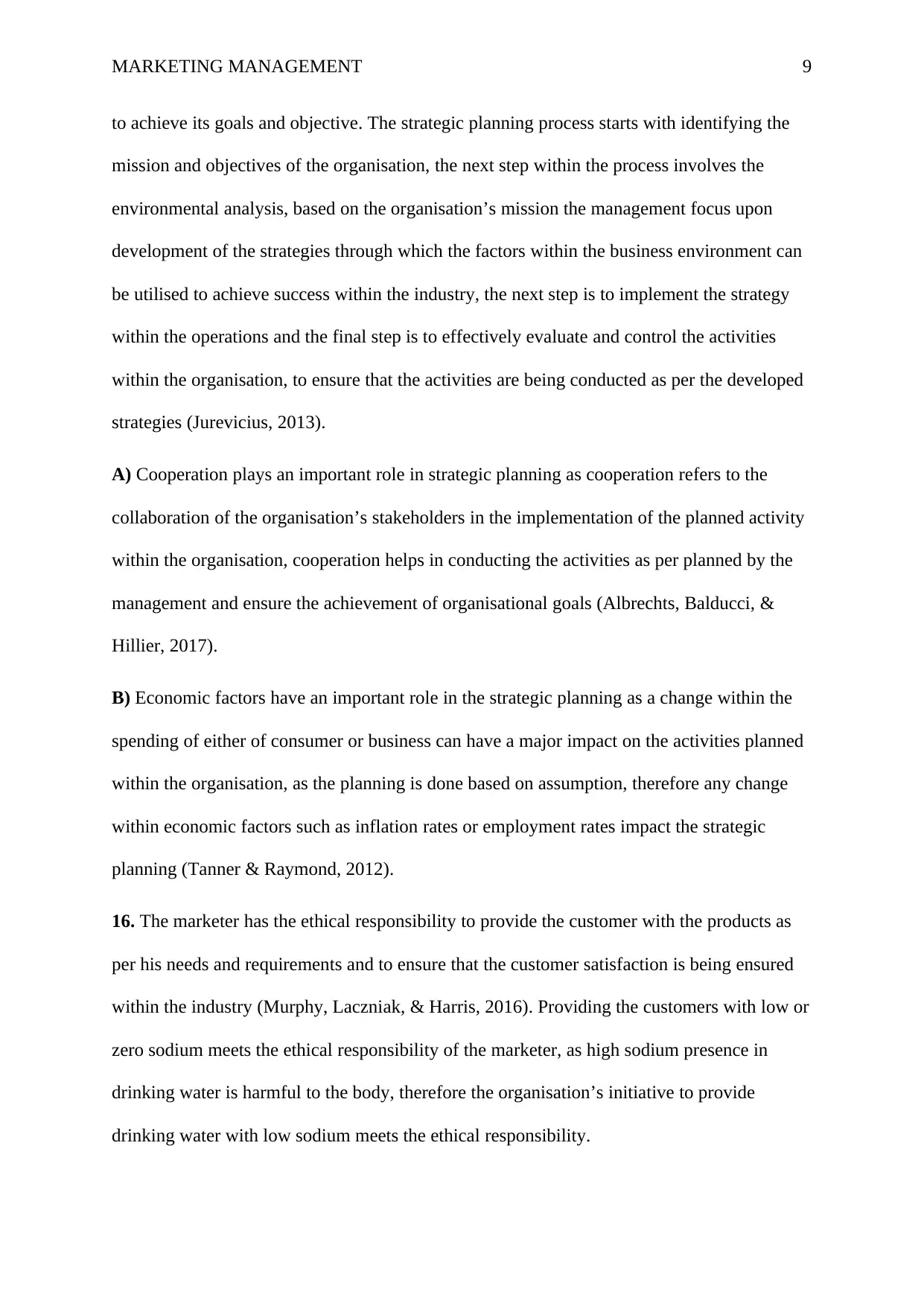
MARKETING MANAGEMENT 9
to achieve its goals and objective. The strategic planning process starts with identifying the
mission and objectives of the organisation, the next step within the process involves the
environmental analysis, based on the organisation’s mission the management focus upon
development of the strategies through which the factors within the business environment can
be utilised to achieve success within the industry, the next step is to implement the strategy
within the operations and the final step is to effectively evaluate and control the activities
within the organisation, to ensure that the activities are being conducted as per the developed
strategies (Jurevicius, 2013).
A) Cooperation plays an important role in strategic planning as cooperation refers to the
collaboration of the organisation’s stakeholders in the implementation of the planned activity
within the organisation, cooperation helps in conducting the activities as per planned by the
management and ensure the achievement of organisational goals (Albrechts, Balducci, &
Hillier, 2017).
B) Economic factors have an important role in the strategic planning as a change within the
spending of either of consumer or business can have a major impact on the activities planned
within the organisation, as the planning is done based on assumption, therefore any change
within economic factors such as inflation rates or employment rates impact the strategic
planning (Tanner & Raymond, 2012).
16. The marketer has the ethical responsibility to provide the customer with the products as
per his needs and requirements and to ensure that the customer satisfaction is being ensured
within the industry (Murphy, Laczniak, & Harris, 2016). Providing the customers with low or
zero sodium meets the ethical responsibility of the marketer, as high sodium presence in
drinking water is harmful to the body, therefore the organisation’s initiative to provide
drinking water with low sodium meets the ethical responsibility.
to achieve its goals and objective. The strategic planning process starts with identifying the
mission and objectives of the organisation, the next step within the process involves the
environmental analysis, based on the organisation’s mission the management focus upon
development of the strategies through which the factors within the business environment can
be utilised to achieve success within the industry, the next step is to implement the strategy
within the operations and the final step is to effectively evaluate and control the activities
within the organisation, to ensure that the activities are being conducted as per the developed
strategies (Jurevicius, 2013).
A) Cooperation plays an important role in strategic planning as cooperation refers to the
collaboration of the organisation’s stakeholders in the implementation of the planned activity
within the organisation, cooperation helps in conducting the activities as per planned by the
management and ensure the achievement of organisational goals (Albrechts, Balducci, &
Hillier, 2017).
B) Economic factors have an important role in the strategic planning as a change within the
spending of either of consumer or business can have a major impact on the activities planned
within the organisation, as the planning is done based on assumption, therefore any change
within economic factors such as inflation rates or employment rates impact the strategic
planning (Tanner & Raymond, 2012).
16. The marketer has the ethical responsibility to provide the customer with the products as
per his needs and requirements and to ensure that the customer satisfaction is being ensured
within the industry (Murphy, Laczniak, & Harris, 2016). Providing the customers with low or
zero sodium meets the ethical responsibility of the marketer, as high sodium presence in
drinking water is harmful to the body, therefore the organisation’s initiative to provide
drinking water with low sodium meets the ethical responsibility.
Paraphrase This Document
Need a fresh take? Get an instant paraphrase of this document with our AI Paraphraser

MARKETING MANAGEMENT 10
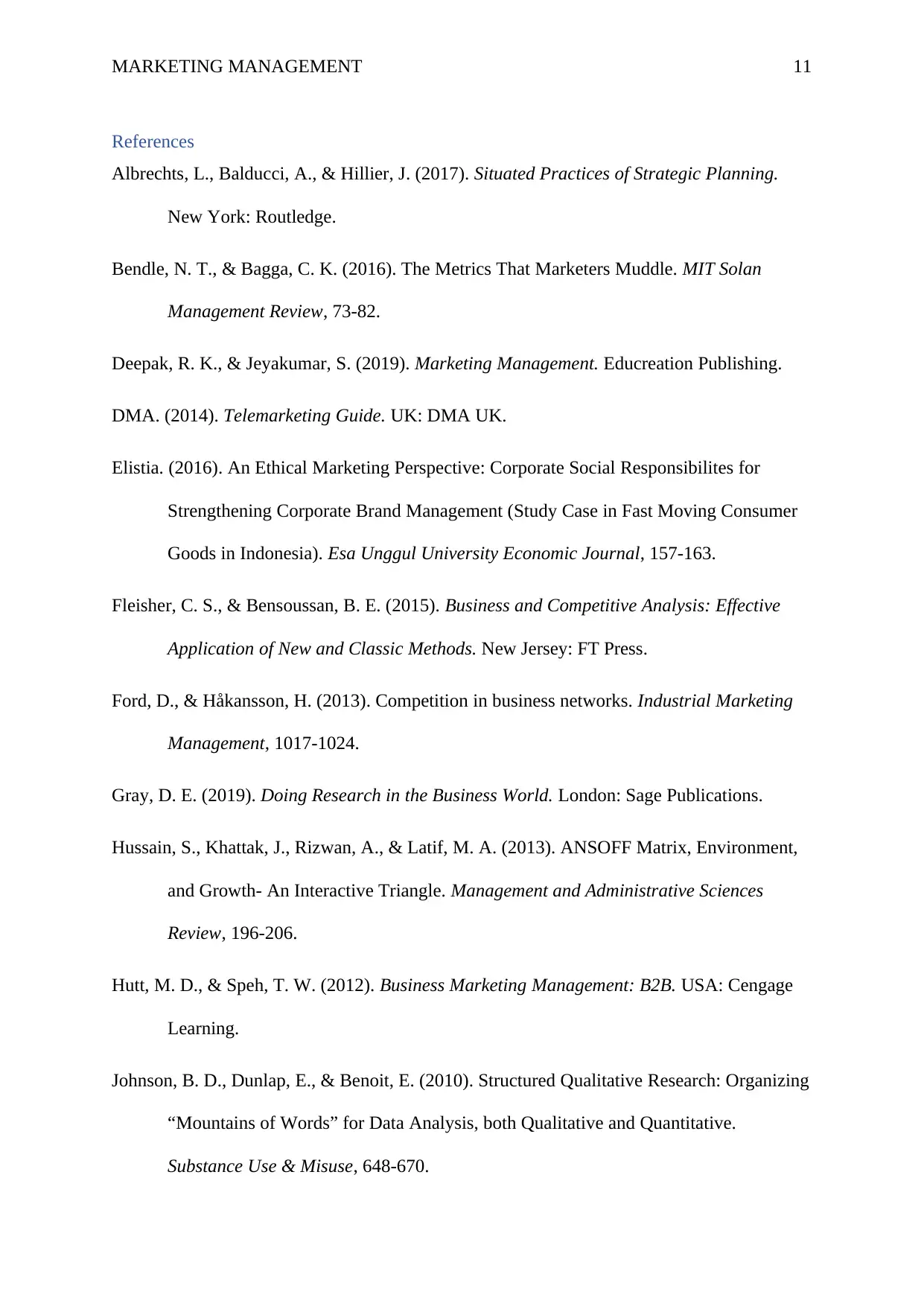
MARKETING MANAGEMENT 11
References
Albrechts, L., Balducci, A., & Hillier, J. (2017). Situated Practices of Strategic Planning.
New York: Routledge.
Bendle, N. T., & Bagga, C. K. (2016). The Metrics That Marketers Muddle. MIT Solan
Management Review, 73-82.
Deepak, R. K., & Jeyakumar, S. (2019). Marketing Management. Educreation Publishing.
DMA. (2014). Telemarketing Guide. UK: DMA UK.
Elistia. (2016). An Ethical Marketing Perspective: Corporate Social Responsibilites for
Strengthening Corporate Brand Management (Study Case in Fast Moving Consumer
Goods in Indonesia). Esa Unggul University Economic Journal, 157-163.
Fleisher, C. S., & Bensoussan, B. E. (2015). Business and Competitive Analysis: Effective
Application of New and Classic Methods. New Jersey: FT Press.
Ford, D., & Håkansson, H. (2013). Competition in business networks. Industrial Marketing
Management, 1017-1024.
Gray, D. E. (2019). Doing Research in the Business World. London: Sage Publications.
Hussain, S., Khattak, J., Rizwan, A., & Latif, M. A. (2013). ANSOFF Matrix, Environment,
and Growth- An Interactive Triangle. Management and Administrative Sciences
Review, 196-206.
Hutt, M. D., & Speh, T. W. (2012). Business Marketing Management: B2B. USA: Cengage
Learning.
Johnson, B. D., Dunlap, E., & Benoit, E. (2010). Structured Qualitative Research: Organizing
“Mountains of Words” for Data Analysis, both Qualitative and Quantitative.
Substance Use & Misuse, 648-670.
References
Albrechts, L., Balducci, A., & Hillier, J. (2017). Situated Practices of Strategic Planning.
New York: Routledge.
Bendle, N. T., & Bagga, C. K. (2016). The Metrics That Marketers Muddle. MIT Solan
Management Review, 73-82.
Deepak, R. K., & Jeyakumar, S. (2019). Marketing Management. Educreation Publishing.
DMA. (2014). Telemarketing Guide. UK: DMA UK.
Elistia. (2016). An Ethical Marketing Perspective: Corporate Social Responsibilites for
Strengthening Corporate Brand Management (Study Case in Fast Moving Consumer
Goods in Indonesia). Esa Unggul University Economic Journal, 157-163.
Fleisher, C. S., & Bensoussan, B. E. (2015). Business and Competitive Analysis: Effective
Application of New and Classic Methods. New Jersey: FT Press.
Ford, D., & Håkansson, H. (2013). Competition in business networks. Industrial Marketing
Management, 1017-1024.
Gray, D. E. (2019). Doing Research in the Business World. London: Sage Publications.
Hussain, S., Khattak, J., Rizwan, A., & Latif, M. A. (2013). ANSOFF Matrix, Environment,
and Growth- An Interactive Triangle. Management and Administrative Sciences
Review, 196-206.
Hutt, M. D., & Speh, T. W. (2012). Business Marketing Management: B2B. USA: Cengage
Learning.
Johnson, B. D., Dunlap, E., & Benoit, E. (2010). Structured Qualitative Research: Organizing
“Mountains of Words” for Data Analysis, both Qualitative and Quantitative.
Substance Use & Misuse, 648-670.
⊘ This is a preview!⊘
Do you want full access?
Subscribe today to unlock all pages.

Trusted by 1+ million students worldwide
1 out of 14
Related Documents
Your All-in-One AI-Powered Toolkit for Academic Success.
+13062052269
info@desklib.com
Available 24*7 on WhatsApp / Email
![[object Object]](/_next/static/media/star-bottom.7253800d.svg)
Unlock your academic potential
Copyright © 2020–2025 A2Z Services. All Rights Reserved. Developed and managed by ZUCOL.




